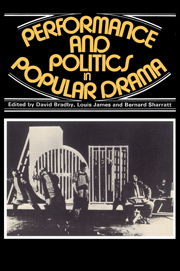 Performance and Politics in Popular Drama
Performance and Politics in Popular Drama Book contents
- Frontmatter
- Contents
- List of contributors
- Preface
- Acknowledgements
- PART ONE Spectacle, performance and audience in nineteenth-century theatre
- Introduction
- Was Jerrold's Black Ey'd Susan more popular than Wordsworth's Lucy?
- Word and image in Pixérécourt's melodramas: the dramaturgy of the strip-cartoon
- Joseph Bouchardy: a melodramatist and his public
- The music of melodrama
- Popular theatre in Victorian Birmingham
- Water drama
- Equestrian drama and the circus
- Theatre of war: the Crimea on the London stage 1854–5
- Popular drama and the mummers' play
- PART TWO Politics and performance in twentieth-century drama and film
- PART THREE Problems and prospects
- Appendix: Tempo, Tempo
- Select bibliography
- General index
- Index of titles of plays, films, sketches
- Index of theatres, theatre companies and groups
Theatre of war: the Crimea on the London stage 1854–5
Published online by Cambridge University Press: 08 March 2010
- Frontmatter
- Contents
- List of contributors
- Preface
- Acknowledgements
- PART ONE Spectacle, performance and audience in nineteenth-century theatre
- Introduction
- Was Jerrold's Black Ey'd Susan more popular than Wordsworth's Lucy?
- Word and image in Pixérécourt's melodramas: the dramaturgy of the strip-cartoon
- Joseph Bouchardy: a melodramatist and his public
- The music of melodrama
- Popular theatre in Victorian Birmingham
- Water drama
- Equestrian drama and the circus
- Theatre of war: the Crimea on the London stage 1854–5
- Popular drama and the mummers' play
- PART TWO Politics and performance in twentieth-century drama and film
- PART THREE Problems and prospects
- Appendix: Tempo, Tempo
- Select bibliography
- General index
- Index of titles of plays, films, sketches
- Index of theatres, theatre companies and groups
Summary
War is a major subject of popular art; its connotations and associated values – the notions of heroism, daring, stoicism, acclaim, victory, comradeship, patriotism – are created, and reinforced, between the sword and the song. When Percy wi' the Douglas met, the job of the singer who reported and immortalised the conflict was comparatively simple. His public expected the details of the fight, and those he gave them were in the expected form, carrying the expected assumptions, and they were accepted as a record of facts. The function of the reporter was not separate from that of the artist: he delivered and shaped reality. When the broadside writer and afterwards the equestrian dramatist created the Battle of Waterloo for public consumption, little had changed. Hard news was brief, or forbiddingly couched in official despatches, and the myth of Napoleon was a much stronger power in the minds of the British public than any desire for dry truth. The voice of the people was still that of the balladeer who wrote ‘Not a drum was heard, not a funeral note’, rather than that of the Times correspondent who failed to report after the Battle of Corunna that Sir John Moore had been killed.
In the middle of the nineteenth century, however, the advent of accurate and fast news reporting affected popular art profoundly. In 1854 the outbreak of the first real war for forty years showed up very sharply the extent and nature of the effect of newspapers upon the older forms, broadside ballads, songs and plays.
- Type
- Chapter
- Information
- Performance and Politics in Popular DramaAspects of Popular Entertainment in Theatre, Film and Television, 1800–1976, pp. 119 - 138Publisher: Cambridge University PressPrint publication year: 1980
- 1
- Cited by


